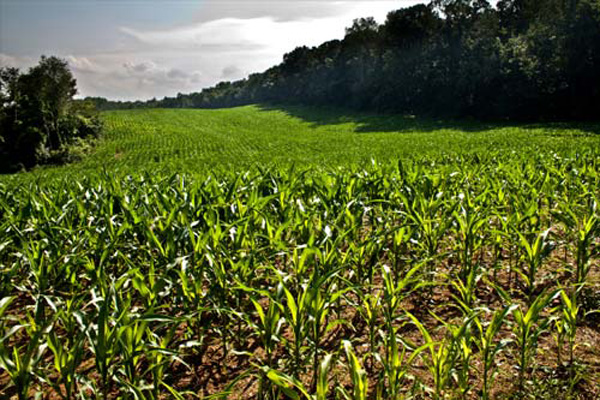-

Erin Donahue -

Christina Barkanic -

Brittany Trott -

Emily Wiley -

Jessica Reilley -

Chris Raines -

Will Nichols -

Emily Reddy -

Michele Marchetti -

Michele Frank -

James Gherardi -

Kit Henshaw -

Christina and Erin -

Kim Tait -

Erin McKinney -

Steve Spanelli -

Sam Komlenic -

Katherine Taylor Grofic -

James Eisenstein -

Jamie Oberdick -

Anna Lombardo -

LacCreta Holland -

Tony Ricci -

Local Food Journey -

Laura Young -

Kristin Camplese -

Harrison's Fresh + Local -

Danielle Matalonis -

Kristine A. -

Linda Weaver -

Naomi Elle Schwartz -

Dana Stuchul -

Cara McShane -

Brittany Smith -

Jessica Illuzzi - Frosty
-

Jessica Paholsky -

James Sechrengost -

Brad Yeckley -

Maya Althouse -

Jordan Reabold -

Kim Chase -

Maria Bryant - Alexandrea Scott
Why Organic? Part 5: GMOs
Posted by James Eisenstein on 04/16, 2012 at 08:31 AM

You won’t see weeds in this Centre County field planted with Monsanto’s “Roundup Ready†corn, but you will be ingesting GMO corn when you eat products made from it.
Two fundamental truths proved most useful to students in my environmental politics class—both from the field of ecology. The first is, “You can’t do just one thing.†The second explains why the first is true: “Everything is connected to everything else.â€
Previous parts of this “Why Organic†series illustrate the usefulness of these two principles. A conventional farmer can’t just kill harmful insects or noxious weeds or boost crop growth with chemical fertilizers without doing other not so wonderful things. Not so wonderful things include killing pollinators and other beneficial insects, depleting the soil, reducing the nutritional content of food, and jeopardizing human health with pesticide and herbicide residues in food.
A third nifty concept, the “precautionary principle,†helps one understand why methods used to conclude that conventional practices are “safe†are fundamentally flawed.
Standards employed to certify that new pesticides and genetically modified organisms (GMOs) are safe require scientific proof. But how do you prove lack of harm? If mice are fed a diet containing a new pesticide, and they seem fine, it is accepted as evidence that the pesticide it is safe for us. The burden of proof falls on those (if there are any) who claim it is unsafe, rather than on the manufacturer seeking to license it.
When messing around with Mother Nature, risking doing permanent, irreversible harm, it makes sense to proceed differently. In its simplest form, the precautionary principle states that if the effect of an action on the environment and human health is unknown, don’t do it! Instead, assume harm at the outset and try to minimize it. Recognize that people make mistakes, especially if they profit from an action they claim is safe. It shifts the burden of proof. When consequences are uncertain, proponents need to establish safety.
This is a fundamentally conservative approach. If we reasonably suspect harm, and if we don’t know the consequences of introducing one new thing (remember: you can’t do just one thing and assume everything is connected to everything else), then we shouldn’t license and use it. The precautionary principle also suggests we should search for the least harmful path rather than trying to determine “how much harm should we permit.â€
Unfortunately, the precautionary principle has not guided decisions in our country about the safety of genetic manipulation. It’s different elsewhere, however. European countries have banned foods containing GMOs, and public opinion in Europe strongly opposes their use. But in the US, food containing GMOs is everywhere. Virtually all non-organic processed foods containing corn, soy, or canola come from Monsanto’s GMO “Roundup Ready†patented crops.
Have foods derived from GMO crops been proven safe? Do we know the long term health effects of them? Not hardly. Is there enough evidence suggesting that they may cause harm to conclude that a sufficient risk exists to warrant avoiding them, as the precautionary principle requires?
I’m no expert, but I have researched the topic enough to conclude that the answer is yes. Check out Jeffrey M. Smith’s book, Genetic Roulette: The Documented Risks of Genetically Engineered Foods or a series of articles at http://gmo.mercola.com/.
Certified organic farmers are prohibited from using growing GMO crops. This is just one more reason to eat organically produced food whenever you can.
![]() Author: James Eisenstein
Author: James Eisenstein
Bio: Unpaid Field Hand at Jade Family Farm | Former Penn State Professor
- Our Local Food Journey comes to an end
- Winter isn’t a quiet time at the farm
- Get the taste of garden season right now by growing herbs indoors
- All you need to know about PASA’s Farming for the Future conference









NO COMMENTS